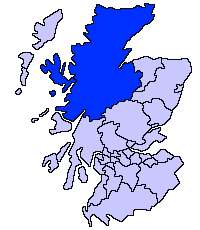 |
| Highland council area Shown as one of the council areas of Scotland |
| 1995 to 1999 wards |
| 1999 to 2007 wards |
| 2007 to 2017 wards |
| 2017 wards |
The third set of Highland Council wards, [1] 22 in number, became effective for election purposes in 2007, for the fourth general election of the Highland Council. The new wards were created under the Local Governance (Scotland) Act 2004, and are as defined in recommendations of the Local Government Boundary Commission for Scotland. [2]
Contents
- Lists of wards created in 2007
- Caithness, Sutherland and Easter Ross wards
- Inverness, Nairn and Badenoch and Strathspey wards
- Ross, Skye and Lochaber wards
- Changes since 2007
- See also
- Notes and references
The Highland Council (Comhairle na Gaidhealtachd in Gaelic) had become a local government authority in 1996, when the two-tier system of regions and districts was abolished and the Highland region became a unitary council area, under the Local Government etc (Scotland) Act 1994. The first Highland Council election, however, was one year earlier, in 1995. Until 1996 councillors shadowed the regional and district councils and planned for the transfer of powers and responsibilities. Elections to the council are normally on a four-year cycle, all wards being contestable at each election.
For the periods 1995 to 1999 each of 72 wards had elected one councillor by the first past the post system. For the period 1999 to 2007, each of 80 wards had elected one councillor by the same system. In 2007, single-member, first past the post wards were replaced by 22 multi-member wards, each electing three or four councillors by the single transferable vote system, to produce a form of proportional representation.
Until 2007 each council ward had been related to one of eight council management areas. In 2007 the council decided to replace the management areas with three new corporate management areas, named as (1) Caithness, Sutherland and Easter Ross, (2) Ross, Skye and Lochaber and (3) Inverness, Nairn and Badenoch and Strathspey, and designed for those services that could not be effectively or efficiently delivered and managed at ward level. [3] Two of these names are also those of Westminster Parliament (House of Commons) constituencies, and one name is very similar to the name of another Westminster constituency, but constituency and corporate management area boundaries are different. Each corporate management area consists of a whole number of wards.
For ward-level management purposes ten wards are stand-alone areas, eleven are merged into larger areas, and one is divided between two areas. Also, seven wards are grouped into an Inverness city management area.
The wards are numbered as well as named.